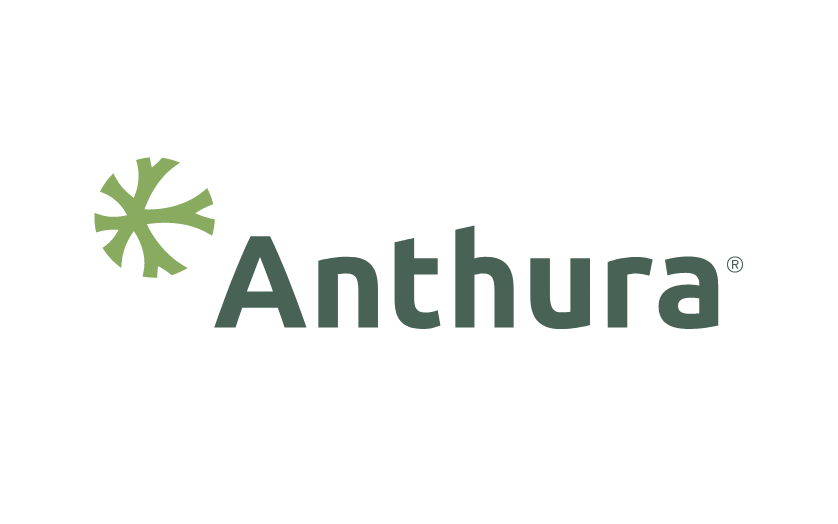The main key to a successful cut Anthurium cultivation is the creation and maintenance of optimal crop structure. A cut Anthurium crop has an LAI (Leaf Area Index) of 3 to 4. This means that the crop has 3-4 m2 leaves per square metre of greenhouse surface. Thanks to suitable crop structure, all leaf layers can intercept an optimal amount of light. Also in the lower leaves photosynthesis will increase and the total crop assimilation will reach a higher level. In addition, the lower leaf layers also receive more radiation energy, as a result of which the plant parts in the crop have a qualitatively better structure.
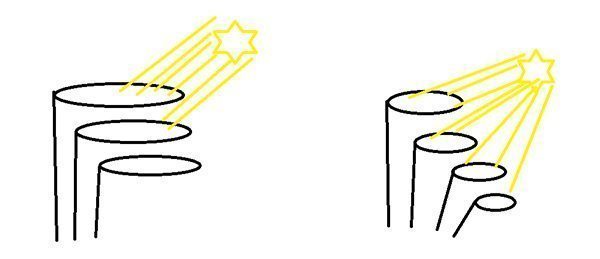
Bad incidence of light (left) and Good incidence of light (right)
This has several consequences, because the plant produces:
-more flowers
With increased assimilation, more sugars become available and the production per plant will increase. There is also more space for cuttings. Extra cuttings automatically imply more flowers in the case of sufficient crop assimilation. All these factors together can ensure that production is higher by up to 40% than with a traditional cultivation.
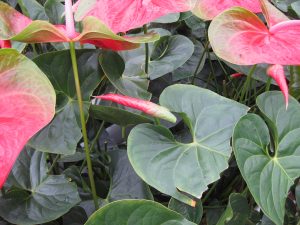
Optimal diversity by halving the leaf
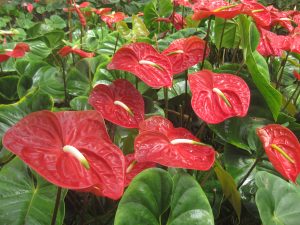
Combination of leaf halving and young leaf breaking
-larger flowers
When the number of plants per square metre remains the same because surplus cuttings are removed, the extra assimilates will lead to larger flowers.
-fewer second types
Flower buds are better able to grow through the crop, as they find fewer large leaves in the growing phase. As a result, the number of bent stems decreases. The flowers and buds also experience less impact from the crop while growing, as a result of which damage to flowers and buds will decrease.
-a shorter crop
As more light reaches the crop, the internodes stay shorter and the crop stretches less quickly. A shorter crop requires less labour and production improves because the plants grow straight for longer.
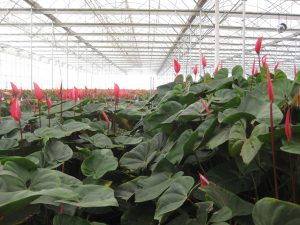
Situation after two-and-a-half years, to the left, halving leaves and breaking young leaves; to the right, only halving the leaves
Creating the proper crop structure
Optimal production calls for proper crop structure of the plant. A distinction can be made between the structure of the plant immediately after planting and an adult crop.
Young crop immediately after planting
First, the crop should grow a dense cover. The small lower leaf does not have to be removed. When the new leaves reach approximately 30 x15 cm, they can be halved. From this point the new leaves can be halved continuously.
If the crop grows too dense, you can start by removing leaves. This can be done in two ways. First of all, the third or fourth leaf can be removed from above, which will open the crop more. Secondly, you can start by removing the small lower leaves. As the crop gets older and fuller, the higher leaves can be removed. The first option gives more diversity and improves the light penetration in the crop, but is more difficult to execute.
Existing adult crop
You can start immediately by halving young leaves. The older tough leaves can be halved by cutting them with large scissors. Please take hygiene requirements into account. Leave a minimum of three halved leaves on the plant.
Maintaining the right crop architecture
Young leaf breaking can be useful when maintaining and improving crop diversity. By combining the traditional leaf-halving system (continuously halving the leaves) with young leaf breaking, an optimally-structured crop can be achieved. This can be done by breaking away every second young leaf. This means that leaf one (viewed from above) is halved and the new leaf (number two) is broken away. Leaf three then needs to be halved.
Number of leaves per plant
The number of torn leaves per plant ultimately depends on:
– the variety, which determines the leaf format, internodes and length of the leaf stalk;
– the number of plants per square metre;
– the size of the leaf tear: 1/2 , 2/3 or 3/4 .
The number of halved leaves per plant will often range from:
6-8 torn leaves in young crops (including all the lower leaves);
Three torn leaves in varieties with a large leaf (Tropical®, Calisto®, Marysia® etc.);
4-5 torn leaves in varieties with smaller leaves (Midori®, Moments®, Tropic night®).
The total leaf occupation of the crop ultimately determines how much leaf is to be kept per growth tip.

Example of leaf dimensions after tearing. From left to right: 1/2 leaf, 2/3 leaf, 3/4 leaf
Traditional leaf cutting
This method does not offer the advantages of the techniques described above, but if the sale of leaves represents more than one-quarter of the crop turnover, then traditional leaf cutting can still be the best choice financially.
Maximizing space on the pathway for optimal crop architecture
By leaving the paths optimally occupied with leaves, the crop surface is often enlarged and the crop assimilation increases. This can be achieved by putting the leaves under the wire and keeping the flowers behind the wire. In addition, with falling crops the plants should not be guided to the middle of the bed, but allowed to fall along the length of the bed. Lower the upper crop wire so the leaf can take advantage of the open space on the path.
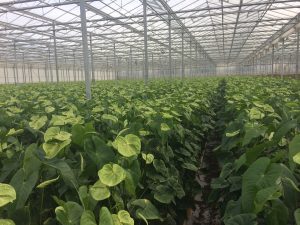
Leaves on the path ensure optimal crop assimilation
Cuttings
When, within 6-9 months after planting, more than one cutting per two plants takes place, the superfluous cuttings need to be removed. If more cuttings are left, the competition between the main plants and the cuttings becomes too fierce. The consequence is that the main plants do not develop properly.
There are two types of cuttings: normal cuttings and eye-cuttings. Normal cuttings are young plants that develop down at the base of the plant at the separation between the substrate and the air. This type of cutting grows slowly and is not very productive, as it receives little light. Eye-cuttings, on the other hand, originate at the growth tip of the plant. They are vigorous and can come to flower production in a few months’ time, because they benefit from the assimilates made by the mother plant.
The formation of this type of cutting can be stimulated easily in young crops (0.5-1.5 years) by:
– implementing optimal crop architecture (see article);
– starting in the optimal growth season with young leaf breaking (in Europe, from midway through February until the end of April). By removing young leaves, more assimilates become available for the cuttings. The formation of auxin (a plant hormone made by young leaves) is also prevented. Auxin also prevents eyes (from which the cutting originates) from growing.
– seeking the maximum light level (10-12 mole/m2/day at crop level), maintaining a relatively low 24-hour temperature (about 21ºC) and ensuring other climate conditions are optimized (RH and CO2).
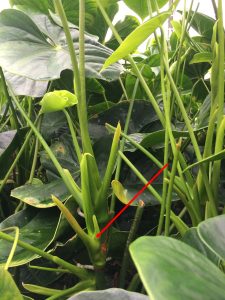
Eye cutting on the mother plant
The following table shows an overview of the climate parameters suitable for eye-cutting formation in combination with young leaf breaking:
| Desirable | ||||
| Day | Night | 24 hrs/som | ||
| Light | 400 µmol/m2/s / 20-25klux | – | 10-12 mol/m² | |
| Temperature | <25ºC | 19ºC | 21,5ºC | |
| CO2 | 800 ppm | – | – | |
| Moisture deficit (MD)/RH | 6 gr/m³ / 80% | >2 gr/m³/<95º | – | |
Optimum climate parameters for the formation of eye-cuttings
By following the information in this article, your cut Anthurium cultivation will achieve optimal crop architecture. This should lead to an increase in production of up to 40%.
Anthurinfo
This article is part of the Anthurinfo February 2017. Read all articles here.
This article has been prepared with the cooperation of Bureau IMAC. Anthura and Bureau IMAC cannot be held responsible for any damages, whether direct or indirect, resulting from the use of the cultivation advice given.
Optional (depending on the article)
- The grower is at all times responsible for consulting the label of crop protection products.
- The cultivation information provided is geared towards Dutch growing locations.
